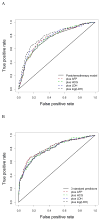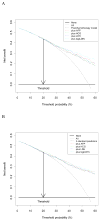Assessing the incremental value of diagnostic and prognostic markers: a review and illustration
- PMID: 21726217
- PMCID: PMC3587963
- DOI: 10.1111/j.1365-2362.2011.02562.x
Assessing the incremental value of diagnostic and prognostic markers: a review and illustration
Abstract
Background: New markers may improve prediction of diagnostic and prognostic outcomes. We review various measures to quantify the incremental value of markers over standard, readily available characteristics.
Methods: Widely used traditional measures include the improvement in model fit or in the area under the receiver operating characteristic (ROC) curve (AUC). New measures include the net reclassification index (NRI) and decision-analytic measures, such as the fraction of true-positive classifications penalized for false-positive classifications [net benefit (NB)]. For illustration, we discuss a case study on the presence of residual tumour vs. benign tissue in 544 patients with testicular cancer. We assessed three tumour markers [Alpha-fetoprotein (AFP), Human chorionic gonadotropin (HCG) and Lactate dehydrogenase (LDH)] for their incremental value over currently standard clinical predictors.
Results: AUC and R(2) values suggested adding continuous LDH and AFP whereas NB only favoured HCG as a potentially promising marker at a clinically defendable decision threshold of 20% risk. The NRI suggested reclassification potential of all three markers.
Conclusions: The improvement in standard discrimination measures, which focus on finding variables that might be promising across all decision thresholds, may not detect the most informative markers at a specific threshold of particular clinical relevance. When a marker is intended to support decision-making, calculation of the improvement in a decision-analytic measure, such as NB, is preferable over an overall judgment as obtained from the AUC in ROC analysis.
© 2011 The Authors. European Journal of Clinical Investigation © 2011 Stichting European Society for Clinical Investigation Journal Foundation.
Figures



References
-
- Ioannidis JP. Expectations, validity, and reality in omics. J Clin Epidemiol. 2010;63:945–949. - PubMed
-
- Janssens AC, Ioannidis JP, Bedrosian S, Boffetta P, Dolan SM, Dowling N, Fortier I, Freedman AN, Grimshaw JM, Gulcher J, et al. Strengthening the reporting of genetic risk prediction studies (GRIPS): explanation and elaboration. Eur J Clin Invest 2011 - PubMed
-
- Kattan MW. Judging new markers by their ability to improve predictive accuracy. J Natl Cancer Inst. 2003;95:634–635. - PubMed
-
- McShane LM, Altman DG, Sauerbrei W, Taube SE, Gion M, Clark GM. Reporting recommendations for tumor marker prognostic studies (REMARK) J Natl Cancer Inst. 2005;97:1180–1184. - PubMed
-
- Wilson PW, D’Agostino RB, Levy D, Belanger AM, Silbershatz H, Kannel WB. Prediction of coronary heart disease using risk factor categories. Circulation. 1998;97:1837–1847. - PubMed
Publication types
MeSH terms
Substances
Grants and funding
LinkOut - more resources
Full Text Sources
Medical

